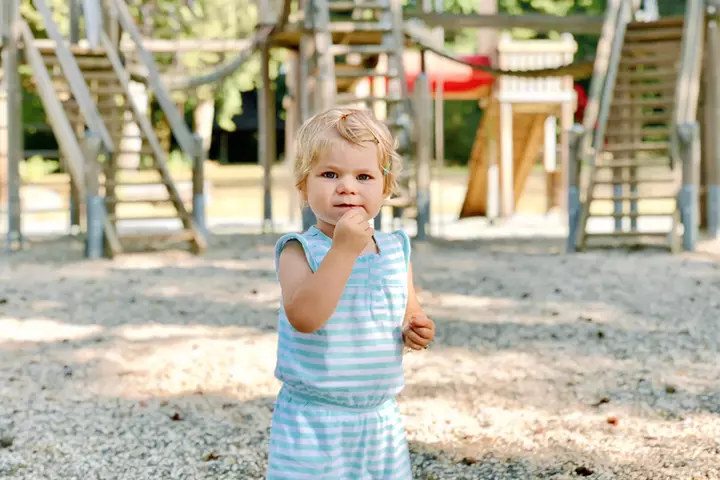
Image: ShutterStock
It is important to understand a toddler’s napping needs since the right amount of sleep helps them stay active throughout the day. So when do toddlers stop napping, and what signs indicate them?
A toddler needs nearly 12 to 14 hours of sleep in a day. This is distributed among the uninterrupted night sleep plus a few naps in the mornings. A good amount of sleep helps them stay active and play during the day. Also, note that the requirement of a nap also depends on their surroundings (1).
However, this need to nap during the daytime reduces as the toddler grows older (2). Instead, they tend to fulfill their sleep needs at night. So if you are a new parent, it is obvious that you would like to know the signs of this shift. Read on to know more about a toddler’s napping patterns and at what age kids stop napping.
Key Pointers
- Napping time in toddlers is a part of healthy growth and a milestone in development.
- If they take too long to fall asleep at night, look active at the napping time, or don’t act fussy on skipping naps, and sleep early before bedtime, it indicates they don’t need daytime napping.
- Change your toddler’s napping sessions if they skip a nap and do not appear sleepy, fussy, and exhausted.
When Do Toddlers Stop Napping?

Some toddlers may stop napping when they are around two years old, while some may continue taking naps past five years. It depends on their body’s requirements for rest and refreshment (3).
Napping time in toddlers is a part of healthy growth and a developmental milestone. A collective review and meta-analysis of children’s napping habits conducted by several institutes reveals that less than 2.5% of children discontinue napping before age two. In contrast, a significant majority of 94% of children stop napping by the age of five. The transition from napping to no napping is gradual and occurs through the following stages.
- Non-stop napping at infancy
- Five to six naps a day when they are 12 months old
- Two to three naps a day when they are 18 months old
- One nap a day when they grow from three to five years old
- No daily daytime naps or once in a few days or weeks after the age of five.
Babies and toddlers need a range of total hours of sleep, and it changes as they grow older. The graph below indicates the number of sleep hours in different age groups. The data suggest that newborns (0-3 months) need at least 14-17 hours, 12-15 hours for infants (4-11 months), and 11-14 hours for toddlers. The number of hours needed tends to decrease as the child grows older.

Sleep duration recommendations across all age groups
Source: Sleep; NHS Greater Glasgow and ClydeWhen Can Napping Be Stopped For Toddlers?
Here are a few signs that show toddlers do not need daytime napping.
- Takes too long to fall asleep at night: If your toddler regains the energy from the daytime napping, it becomes difficult to fall asleep at bedtime. They are not tired and do not demand sleep since their need is fulfilled by daytime napping. If you notice that your toddler won’t sleep, it’s a sign they do not need to nap during the day and are not experiencing exhaustion.
- Looks active at usual napping time: During the regular napping times, if your little one plays and shows their unwillingness to nap, it means they can skip this scheduled nap. A happy mood and no drop in energy levels show they had adequate sleep.
- Doesn’t act fussy on skipping naps: If your toddler exhibits content behavior and is not cranky or fussy on skipping naps, you can put a stop to their usual naps.

- Sleeps early before bedtime: If you find your baby sleepy a little earlier than their regular bedtime and they wake up a little later than usual, it’s a sign that their sleep requirements are being met by nighttime sleep alone.
- Stays awake during car rides: Toddlers often fall asleep during car rides. If your toddler is awake and active during the car rides, you need not force them to sleep during the day, even during their usual napping time.
- Feels irritated when forced to nap: If your toddler is ready to skip naps, their energy levels don’t seem to drop. But when you force them to take a nap, they may feel irritated. This resistance for napping indicates that they don’t require napping time anymore.
After the age of five, the toddler should be able to get most of their sleep at night. If the child needs nap times after the age of five, it may indicate poor quality sleep at night. In such cases, you need to find the reason behind interrupted sleep and help them sleep better at night. You may consult a pediatrician or sleep therapist to rule out any sleep disorder or unnoticed medical condition, causing fatigue (4).
What Are The Signs A Toddler Needs Napping Time?

Sometimes, you may think of stopping your little one’s daytime naps, but it may be too soon for them. If you decide on ending napping, but the toddler’s body needs it, it may affect their development. Here are a few signs that show your baby is not yet ready to end napping.
- They give out baby sleep cues such as yawning, rubbing eyes, sucking thumbs, or cuddling with their loved ones when they feel sleepy.
- Car rides become napping times.
- They become inactive when they skip naps.
- Their energy levels crash by evening.
- They wake up cranky in the morning.
- They behave fussy, irritated, hyperactive, or unhappy throughout the day if napping is disturbed (5) (6).
- They fall asleep in the daycare or class.
- They may be reluctant to learn new things due to tiredness (7).
- They show signs of getting tired during the day.
- They fall asleep quickly during nap times.
 Quick tip
Quick tipHow To Drop A Nap?
If your toddler skips a nap and does not appear sleepy, fussy, and exhausted, it is time to put a stop to their napping sessions.
- Reduce napping time: To help your toddler overcome their nap habits, gradually decrease the nap time from two hours to one hour, and then down to just half an hour over a few weeks. Such gradual cuts will help make it easier to break the habit of napping.
- Provide quiet rest time: Let your little one spend some quiet time. It will provide much-needed relaxation to regain their energy and stay active during daytime activities. Some toddlers may nap on some days, and that is acceptable. Maintain a calm and cozy environment, and try to engage your baby in activities that do not require running around (4). Loren, an author and mother, shares how she introduced the concept of quiet time for her two and half years old son, Logon. Although the quiet time didn’t work for Logon, it made him nap later. She says, “When we returned to Bangkok and kissed jetlag goodbye after a week of readjusting, Logan refused to nap. When it came time for his nap, I would ask him if he’d like to nap or have one hour of quiet time. He chose quiet time. Logan had to stay in his room for one hour. He was not allowed TV or music during this time, and his quiet time had to be done alone. After about a week, though, quiet time started to get old (and frankly, very boring) for Logan. After realizing that quiet time was not what it was cracked up to be, I began trying the naps again about three weeks in. And guess what, folks? It worked. (ⅰ).’’

- Books
- Audio-books
- Puzzles
- Playing with toys
Quiet routine time is beneficial as the daycare and schools provide rest periods, and this habit will keep your child calm during those periods.
- Reschedule bedtimes: Adjust the bedtime schedule to be an hour earlier than usual and allow the child to wake up late in the morning to ensure their sleep is completed. Toddlers need to complete their total amount of recommended sleep during the night time if they are not taking naps.
- Allow napping on some days: Sometimes, your toddler may fall asleep in the middle of the day. It’s important to let them have naptime once a few days if they wish to, do not try to keep them awake forcefully. Remember, it takes time to break or build any habit.
- Give healthy meals: Feed fresh fruits and vegetables to your little one, keeping their daytime meals light. It will keep the toddlers energetic throughout the day. Heavy meals might make them feel lethargic and sleepy.
- Avoid stimulating drinks, food, and activities before sleeping time: Whether before a scheduled nap time or sleep time at night, avoid giving stimulating food or drinks such as sugary drinks, chocolates or candies, as well as stimulating activities that might make it difficult for your little one to fall asleep.

 Experts say
Experts sayFrequently Asked Questions
1. Why do toddlers fight naps?
Every toddler resists napping at least once. It happens when they are involved in an exciting activity and do not want to be diverted from. It may also occur when they are well-rested and do not feel the need to take a nap. The reason is unknown, but resisting a nap is quite common.
2. Should I put my baby to bed early if they missed a nap?
Remember, you cannot force your child to sleep. If they have missed a nap time and follow a routine, they are most likely to feel sleepy around their usual bedtime. If you notice them rubbing their eyes or yawning before or closer to bedtime, you can surely put them to sleep earlier than usual.
3. How can parents manage the transition from napping to one longer sleep in the day?
Nap time becomes less frequent as your child grows. The transition from napping to one long sleep during the day usually happens around three to five years of age. Parents must keep in mind that the transition should be gradual and daily routines must be adjusted. It can be done when the child shows signs of readiness.
If you are still asking yourself, “When do toddlers stop napping?” you should know that it does not have a definite answer as the situation may differ from child to child. Many external factors play a significant role in disrupting babies’ nap time. Also, do keep in mind that if your baby wants to nap by their choice, do not force them out of it as they may get cranky and annoying.
Infographic: How To Manage Toddler Sleep Once They Stop Napping?
As your toddler ages, the duration and frequency of their naps may reduce, and eventually, they may stop napping during the day. Although it may be a challenging phase for you and your toddler, you may try the tips in this infographic to help your toddler get a night of adequate sleep after they stop napping. Illustration: Momjunction Design Team
Illustration: Sure Signs Toddler Is Ready To Stop Napping

Image: Stable Diffusion/MomJunction Design Team
Is your toddler bidding naptime farewell? It could be worrying to see your baby awake at most times. Learn more about the signs and smoothen the transition with this enlightening video.
Personal Experience: Source
MomJunction articles include first-hand experiences to provide you with better insights through real-life narratives. Here are the sources of personal accounts referenced in this article.
ⅰ. Dealing with the dropped nap.https://toddlejoy.com/tag/toddler/
References:
[editor_policy_text]
1. Suni; How Much Sleep Do Babies and Kids Need?; Sleep Foundation
2. Sleep in Toddlers & Preschoolers; Cleveland Clinic
3. Safe Sleep for Preschool Age Children; Virtual Lab School
4. When Your Toddler Will Stop Napping- Find These 10 Signs; Sleep Advisor
5. C. Mednick; Napping helps preschoolers learn; Proceedings of the National Academy of Sciences (2013)
6. Sleep – children and naps; Better Health Channel; Victoria State Government
7. Naps Can Help Preschool Children Learn; National Institute Of Health
8. Healthy Sleep Habits for Babies and Toddlers; Nationwide Children’s Hospital
Community Experiences
Join the conversation and become a part of our nurturing community! Share your stories, experiences, and insights to connect with fellow parents.
Read full bio of Maria Carmela Villania-Mamauag
Read full bio of Rohit Garoo
Read full bio of Dr. Ritika Shah
Read full bio of Vidya Tadapatri



















